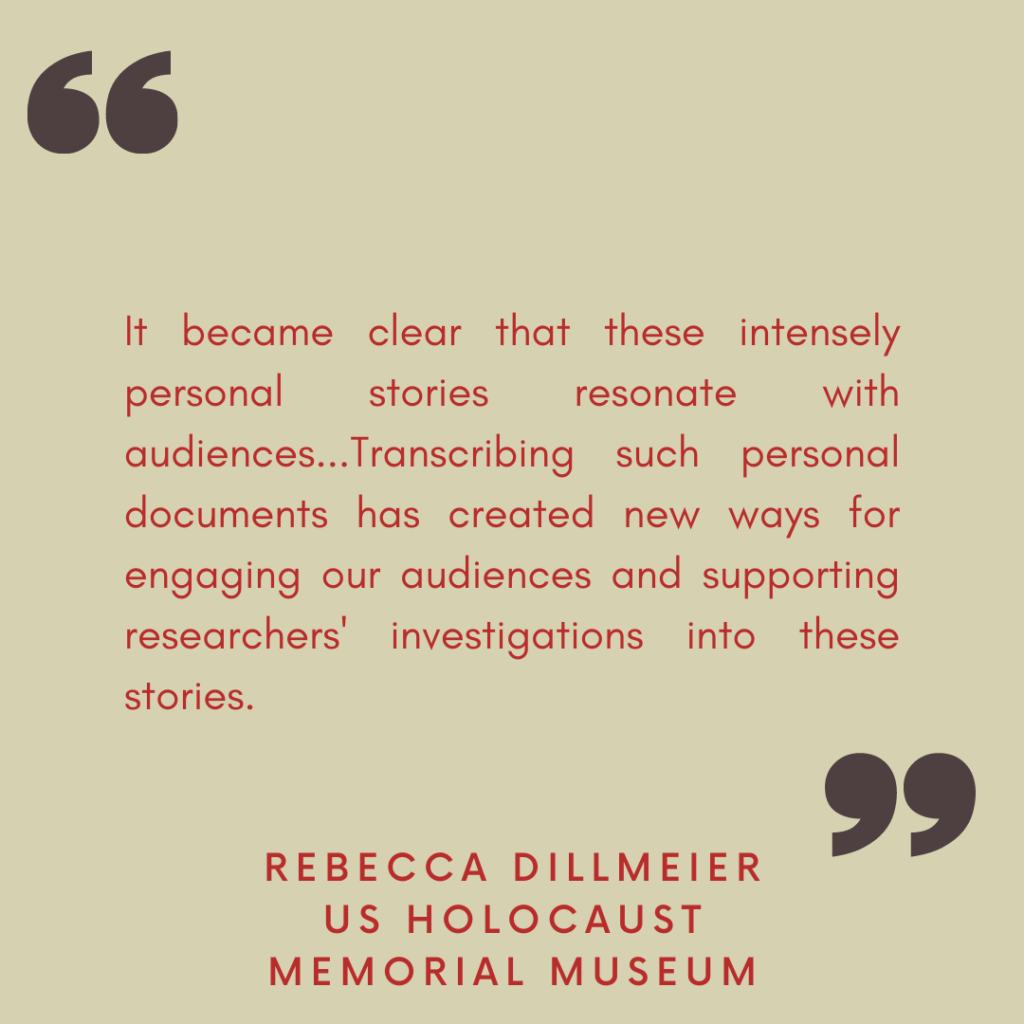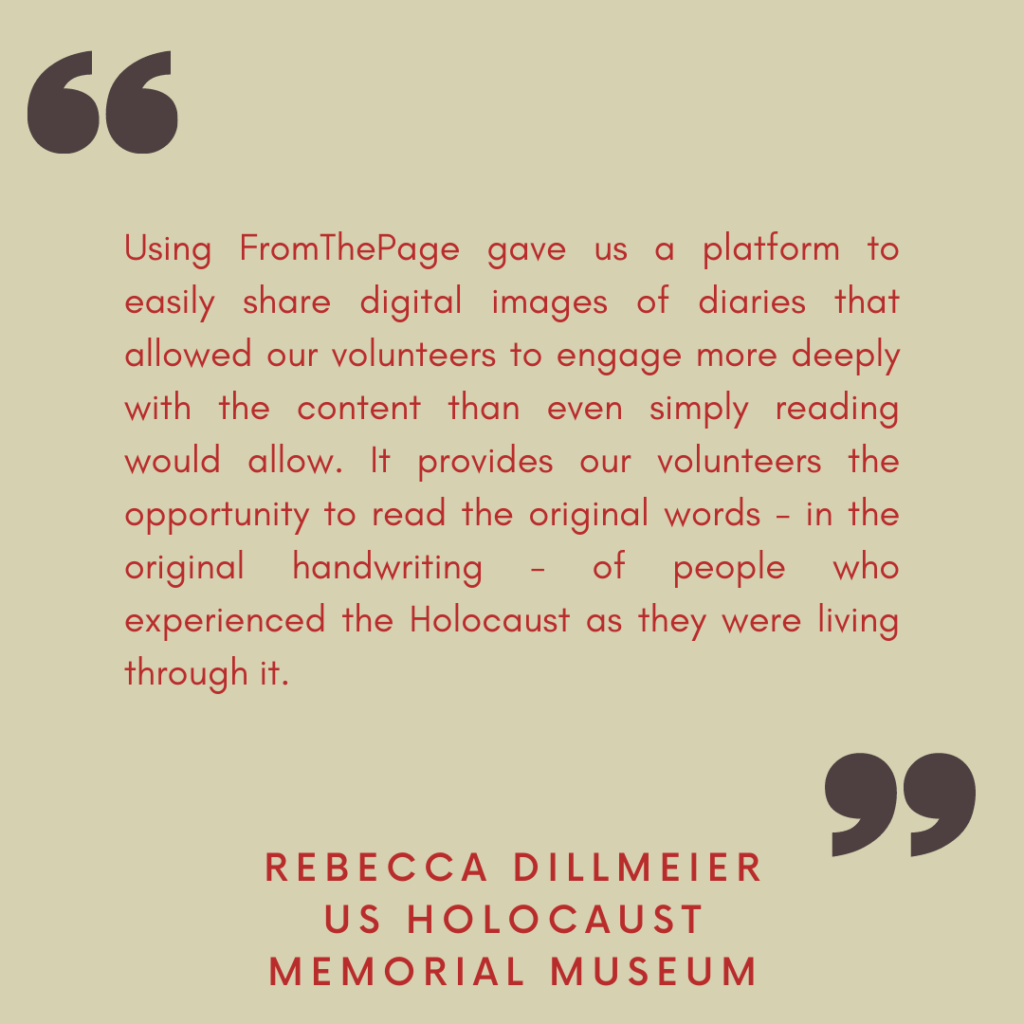
Rebecca Dillmeier of the United States Holocaust Memorial Museum kindly took the time to answer questions from Sara Brumfield of FromThePage, and discussed their project and experience using the platform.
Rebecca Dillmeier is the Digital Collections Manager of the United States Holocaust Memorial Museum.
First, tell us about your documents.
The Museum’s National Institute for Holocaust Documentation houses an unparalleled repository of Holocaust evidence that documents the fate of victims, survivors, rescuers, liberators, and others. Included in this vast archive are the hand-written diaries of some of these people. Each of the diaries has an important story to tell, of suffering and strength, persecution and perseverance. Written by people young and old, from diverse backgrounds and countries, they bring to life a broad spectrum of individuals’ experiences during the Holocaust.
Each of these first-hand accounts speaks to the various reasons why someone would keep a diary - to record their thoughts, events, and hopes for the future; to try to hold onto a sense of self or community; to preserve messages for others; or as a kind of journalism, documenting news of the development of the war and living conditions.
The materials that the diarists used for their journals are just as diverse as the content. Many are notebooks or some form of bound paper, but some are loose sheets, or whatever they could find, such as the backs of correspondence or photographs, material from a munitions factory, margarine wrappers, toilet paper—even the margins of a Bible. While it is extraordinary that these diaries survived, the types of materials can pose challenges for digitization and translation. They can be very fragile, and some parts of the pages may be missing or torn. The handwriting may be faded or illegible. At the same time, the diarists’ determination to journal against all odds is a testament to their strength and courage, given that they often were written under the most challenging conditions and circumstances and had to be hidden, buried, or given to others for safekeeping.
What are your goals for the project?
Initially, we highlighted 13 diaries for transcription and translation to increase access to those first-person written accounts in our collection for a wider audience. It became clear that these intensely personal stories resonate with audiences. We have continued to work to transcribe diaries slowly and make them available through our online Collections Search. Transcribing such personal documents has created new ways for engaging our audiences and supporting researchers' investigations into these stories.
Can you share your experience using FromThePage?
“As a volunteer for the Holocaust Museum, I transcribed and translated Selma Engel’s diary. Not only is it extremely powerful to read all she lived through during and after her imprisonment in Sobibor, but the fact that you see it in her own handwriting makes transcribing it a very emotional experience.” -DutchTranscriber
First-person accounts are extremely powerful. They provide in-the-moment reactions, emotions, and reflections not found elsewhere. Using FromThePage, gave us a platform to easily share digital images of diaries that allowed our volunteers to engage more deeply with the content than even simply reading would allow. It provides our volunteers the opportunity to read the original words - in the original handwriting - of people who experienced the Holocaust as they were living through it.
FromThePage facilitates access beyond the image of a document to the text held within it. Transcription and translation allow these documents to become truly accessible to users who might not work with them otherwise due to access or language barriers.
How does FromThePage & crowdsourcing fit with more traditional museum archive work?
The United States Holocaust Memorial Museum has built the collection of records on the Holocaust for the American people. We strive to make our collection as widely accessible. FromThePage offers both a way for folks to intimately engage with primary source documents while at the same time creating a platform for us to create and then make use of enhanced description. Each transcript created in FromThePage is re-incorporated back into our online Collections Search and helps users discover materials they are interested in.
Traditionally, we have all worked to arrange and describe the collections in our holdings in order to facilitate research and access. Page-level transcription - created by folks who have had a chance to closely read each page - enhances everyone’s ability to find and read our materials. While not all of our original documents are able to be held and read by the public, they can look at a digital image of the page and clearly read the words written on that page right next to it. It provides a way into these moving historical documents.
What would you tell folks considering a similar project?
Establishing our transcription standards provided a real learning opportunity for us. We started from a place of thinking that having an answer for every kind of situation a volunteer would come across was essential. What to do when something is crossed out? Written over? Highlighted? Underlined? Circled? We realized that it was surprisingly unhelpful to be so specific as it created too much documentation for volunteers to sort through and ended up causing more confusion than clarity.
Anything else you'd like to tell us?
Working with FromThePage allowed us to work with volunteers in a new way - giving them easy access to digital images of written first-hand accounts of the Holocaust and us a way to capture that information at the page level. We now have transcripts that we were able to easily make use of in our online Collections Search which allows a user to see the transcript right next to an image of the original document.
Have important historical documents that need transcribing? Book a call with Ben and Sara.



